Electron Push-Pull Effect of Benzotrithiophene-Based Covalent Organic Frameworks on the Photocatalytic Degradation of Pharmaceuticals and Personal Care Products
Abstract
1. Introduction
2. Results
2.1. Structure and Morphology
2.2. Optoelectronic Properties
2.3. Photocatalytic Performance
2.4. Photocatalytic Degradation Mechanism
3. Discussion
4. Materials and Methods
4.1. Synthesis of BTT-TAPT
4.2. Synthesis of BTT-TAPB
4.3. Synthesis of BTT-TAPA
4.4. Photocatalytic Degradation of TC
4.5. Photocatalytic Degradation of CIP
Supplementary Materials
Author Contributions
Funding
Institutional Review Board Statement
Informed Consent Statement
Data Availability Statement
Conflicts of Interest
References
- Tahir, M.B.; Ahmad, A.; Iqbal, T.; Ijaz, M.; Muhammad, S.; Siddeeg, S.M. Advances in photo-catalysis approach for the removal of toxic personal care product in aqueous environment. Environ. Dev. Sustain. 2020, 22, 6029–6052. [Google Scholar] [CrossRef]
- Gworek, B.; Kijenska, M.; Wrzosek, J.; Graniewska, M. Pharmaceuticals in the soil and plant environment: A Review. Water Air Soil Pollut. 2021, 232, 145. [Google Scholar] [CrossRef]
- Kim, S.; Nam, S.N.; Park, C.M.; Jang, M.; Taheri-Qazvini, N.; Yoon, Y. Effect of single and multilayered Ti3C2TX MXene as a catalyst and adsorbent on enhanced sonodegradation of diclofenac and verapamil. J. Hazard. Mater. 2022, 426, 128120. [Google Scholar] [CrossRef]
- Li, S.M.; Ao, X.W.; Li, C.; Lu, Z.D.; Cao, W.F.; Wu, F.F.; Liu, S.M.; Sun, W.J. Insight into PPCP degradation by UV/NH2Cl and comparison with UV/NaClO: Kinetics, reaction mechanism, and DBP formation. Water Res. 2020, 182, 115967. [Google Scholar] [CrossRef]
- Yang, Y.; Ok, Y.S.; Kim, K.H.; Kwon, E.E.; Tsang, Y.F. Occurrences and removal of pharmaceuticals and personal care products (PPCPs) in drinking water and water/sewage treatment plants: A review. Sci. Total Environ. 2017, 596–597, 303–320. [Google Scholar] [CrossRef]
- Uzelac, M.M.; Conic, B.S.; Kladar, N.; Armakovic, S.; Armakovic, S.J. Removal of hydrochlorothiazide from drinking and environmental water: Hydrolysis, direct and indirect photolysis. Energy Environ. 2023, 34, 1243–1257. [Google Scholar] [CrossRef]
- Phoon, B.L.; Ong, C.C.; Saheed, M.S.M.; Show, P.L.; Chang, J.S.; Ling, T.C.; Lam, S.S.; Juan, J.C. Conventional and emerging technologies for removal of antibiotics from wastewater. J. Hazard. Mater. 2020, 400, 122961. [Google Scholar] [CrossRef]
- Singh, P.; Priya, B.; Shandilya, P.; Raizada, P.; Singh, N.; Pare, B.; Jonnalagadda, S.B. Photocatalytic mineralization of antibiotics using 60%WO3/BiOCl stacked to graphene sand composite and chitosan. Arab. J. Chem. 2019, 12, 4627–4645. [Google Scholar] [CrossRef]
- Hu, A.R.; Liu, Y.L.; Zheng, J.F.; Wang, X.M.; Xia, S.J.; van der Bruggen, B. Tailoring properties and performance of thin-film composite membranes by salt additives for water treatment: A critical review. Water Res. 2023, 234, 119821. [Google Scholar] [CrossRef]
- Raizada, P.; Sudhaik, A.; Patial, S.; Hasija, V.; Khan, A.A.P.; Singh, P.; Gautam, S.; Kaur, M.; Nguyen, V.H. Engineering nanostructures of CuO-based photocatalysts for water treatment: Current progress and future challenges. Arab. J. Chem. 2020, 13, 8424–8457. [Google Scholar] [CrossRef]
- Javaid, A.; Imran, M.; Latif, S.; Hussain, N.; Bilal, M. Functionalized magnetic nanostructured composites and hybrids for photocatalytic elimination of pharmaceuticals and personal care products. Sci. Total Environ. 2022, 849, 157683. [Google Scholar] [CrossRef]
- Li, X.Y.; Liu, H.W.; Zhang, Y.S.; Mahlknecht, J.; Wang, C.Q. A review of metallurgical slags as catalysts in advanced oxidation processes for removal of refractory organic pollutants in wastewater. J. Environ. Manag. 2024, 352, 120051. [Google Scholar] [CrossRef] [PubMed]
- Ryu, J.; Yoon, Y.; Oh, J. Occurrence of endocrine disrupting compounds and pharmaceuticals in 11 WWTPs in Seoul, Korea. KSCE J. Civ. Eng. 2011, 15, 57–64. [Google Scholar] [CrossRef]
- Zhou, Y.; Zhang, C.; Huang, D.L.; Wang, W.J.; Zhai, Y.B.; Liang, Q.H.; Yang, Y.; Tian, S.H.; Luo, H.Z.; Qin, D.Y. Structure defined 2D Mo2C/2Dg-C3N4 Van der Waals heterojunction: Oriented charge flow in-plane and separation within the interface to collectively promote photocatalytic degradation of pharmaceutical and personal care products. Appl. Catal. B-Environ. 2022, 301, 120749. [Google Scholar] [CrossRef]
- Wang, X.C.; Maeda, K.; Thomas, A.; Takanabe, K.; Xin, G.; Carlsson, J.M.; Domen, K.; Antonietti, M. A metal-free polymeric photocatalyst for hydrogen production from water under visible light. Nat. Mater. 2009, 8, 76–80. [Google Scholar] [CrossRef] [PubMed]
- Gong, Y.N.; Guan, X.Y.; Jiang, H.L. Covalent organic frameworks for photocatalysis: Synthesis, structural features, fundamentals and performance. Coord. Chem. Rev. 2023, 475, 214889. [Google Scholar] [CrossRef]
- Cheng, H.; Lv, H.F.; Cheng, J.; Wang, L.; Wu, X.J.; Xu, H.X. Rational design of covalent heptazine frameworks with spatially separated redox centers for high-efficiency photocatalytic hydrogen peroxide production. Adv. Mater. 2022, 34, 2107480. [Google Scholar] [CrossRef] [PubMed]
- Pattanayak, D.S.; Pal, D.; Mishra, J.; Thakur, C. Noble metal-free doped graphitic carbon nitride (g-C3N4) for efficient photodegradation of antibiotics: Progress, limitations, and future directions. Environ. Sci. Pollut. Res. 2023, 30, 25546–25558. [Google Scholar] [CrossRef]
- Sharma, R.K.; Yadav, P.; Yadav, M.; Gupta, R.; Rana, P.; Srivastava, A.; Zboril, R.; Varma, R.S.; Antonietti, M.; Gawande, M.B. Recent development of covalent organic frameworks (COFs): Synthesis and catalytic (organic-electro-photo) applications. Mater. Horiz. 2020, 7, 411–454. [Google Scholar] [CrossRef]
- Akyuz, L. An imine based COF as a smart carrier for targeted drug delivery: From synthesis to computational studies. Microporous Mesoporous Mat. 2020, 294, 109850. [Google Scholar] [CrossRef]
- Geng, K.Y.; He, T.; Liu, R.Y.; Dalapati, S.; Tan, K.T.; Li, Z.P.; Tao, S.S.; Gong, Y.F.; Jiang, Q.H.; Jiang, D.L. Covalent organic frameworks: Design, synthesis, and functions. Chem. Rev. 2020, 120, 8814–8933. [Google Scholar] [CrossRef]
- Liu, S.S.; Qian, T.; Wang, M.F.; Ji, H.Q.; Shen, X.W.; Wang, C.; Yan, C.L. Proton-filtering covalent organic frameworks with superior nitrogen penetration flux promote ambient ammonia synthesis. Nat. Catal. 2021, 4, 322–331. [Google Scholar] [CrossRef]
- Wang, X.Y.; Sun, B.H.; Ye, Z.Q.; Zhang, W.J.; Xu, W.; Gao, S.R.; Zhou, N.L.; Wu, F.; Shen, J. Enzyme-responsive COF-based thiol-targeting nanoinhibitor for curing bacterial infections. ACS Appl. Mater. Interfaces 2022, 14, 38483–38496. [Google Scholar] [CrossRef]
- Zhi, Y.F.; Wang, Z.R.; Zhang, H.L.; Zhang, Q.C. Recent progress in metal-free covalent organic frameworks as heterogeneous catalysts. Small 2020, 16, 2001070. [Google Scholar] [CrossRef]
- Côté, A.P.; Benin, A.I.; Ockwig, N.W.; O’Keeffe, M.; Matzger, A.J.; Yaghi, O.M. Porous, crystalline, covalent organic frameworks. Science 2005, 310, 1166–1170. [Google Scholar] [CrossRef]
- Bi, J.H.; Zhang, Z.T.; Tian, J.J.; Huang, G.C. Interface engineering in a nitrogen-rich COF/BiOBr S-scheme heterojunction triggering efficient photocatalytic degradation of tetracycline antibiotics. J. Colloid Interface Sci. 2024, 661, 761–771. [Google Scholar] [CrossRef] [PubMed]
- Shi, Z.X.; Chen, Z.; Zhang, Y.; Wang, X.N.; Lu, T.T.; Wang, Q.; Zhan, Z.L.; Zhang, P. COF TzDa/Ag/AgBr Z-scheme heterojunction photocatalyst for efficient visible light driven elimination of antibiotics tetracycline and heavy metal ion Cr(VI). Sep. Purif. Technol. 2022, 288, 120717. [Google Scholar] [CrossRef]
- Subudhi, S.; Tripathy, S.P.; Parida, K. Highlights of the characterization techniques on inorganic, organic (COF) and hybrid (MOF) photocatalytic semiconductors. Catal. Sci. Technol. 2021, 11, 392–415. [Google Scholar] [CrossRef]
- Hu, S.Y.; Sun, Y.N.; Feng, Z.W.; Wang, F.O.; Lv, Y.K. Design and construction strategies to improve covalent organic frameworks photocatalyst’s performance for degradation of organic pollutants. Chemosphere 2022, 286, 131646. [Google Scholar] [CrossRef] [PubMed]
- Chen, K.; Cai, A.Q.; Li, T.T. Covalent organic framework-semiconductor-based heterostructures for photocatalytic applications. ChemSusChem 2023, 16, e202300021. [Google Scholar] [CrossRef]
- Yang, Y.L.; Niu, H.Y.; Xu, L.; Zhang, H.; Cai, Y.Q. Triazine functionalized fully conjugated covalent organic framework for efficient photocatalysis. Appl. Catal. B-Environ. 2020, 269, 118799. [Google Scholar] [CrossRef]
- Guo, L.P.; Jin, S.B. Stable covalent organic frameworks for photochemical applications. ChemPhotoChem 2019, 3, 973–983. [Google Scholar] [CrossRef]
- Dong, P.F.; Lv, H.F.; Luo, R.A.; Li, Z.; Wu, X.J.; Lei, J.P. Reticular polarization engineering of covalent organic frameworks for accelerated generation of superoxide anion radicals. Chem. Eng. J. 2023, 461, 141817. [Google Scholar] [CrossRef]
- Zhang, K.K.; Huang, F.W.; Dong, X.Y.; Xiong, K.H.; Lang, X.J. Benzotrithiophene-based sp2 carbon-conjugated microporous polymers for green light-triggered oxidation of amines to imines. Mater. Today Chem. 2024, 35, 101879. [Google Scholar] [CrossRef]
- Jin, S.B.; Ding, X.S.; Feng, X.; Supur, M.; Furukawa, K.; Takahashi, S.; Addicoat, M.; El-Khouly, M.E.; Nakamura, T.; Irle, S.; et al. Charge dynamics in a donor-acceptor covalent organic framework with periodically ordered bicontinuous heterojunctions. Angew. Chem.-Int. Ed. 2013, 52, 2017–2021. [Google Scholar] [CrossRef] [PubMed]
- Huang, F.W.; Wang, Y.X.; Dong, X.Y.; Lang, X.J. Imine-linked 2D covalent organic frameworks based on benzotrithiophene for visible-light-driven selective aerobic sulfoxidation. J. Mater. Chem. A 2024, 12, 7036–7046. [Google Scholar] [CrossRef]
- Qin, C.C.; Wu, X.D.; Tang, L.; Chen, X.H.; Li, M.; Mou, Y.; Su, B.; Wang, S.B.; Feng, C.Y.; Liu, J.W.; et al. Dual donor-acceptor covalent organic frameworks for hydrogen peroxide photosynthesis. Nat. Commun. 2023, 14, 5238. [Google Scholar] [CrossRef]
- Zhao, X.; Shang, S.; Liu, H.; Peng, C.; Hu, J. Dipole moment regulation for enhancing internal electric field in covalent organic frameworks photocatalysts. Chemosphere 2024, 356, 141947. [Google Scholar] [CrossRef] [PubMed]
- Qin, C.C.; Yang, Y.; Wu, X.D.; Chen, L.; Liu, Z.L.; Tang, L.; Lyu, L.; Huang, D.L.; Wang, D.B.; Zhang, C.; et al. Twistedly hydrophobic basis with suitable aromatic metrics in covalent organic networks govern micropollutant decontamination. Nat. Commun. 2023, 14, 6470. [Google Scholar] [CrossRef]
- Kaczmarek, A.M.; Liu, Y.Y.; Kaczmarek, M.K.; Liu, H.S.; Artizzu, F.; Carlos, L.D.; Van Der Voort, P. Developing luminescent ratiometric thermometers based on a covalent organic framework (COF). Angew. Chem.-Int. Ed. 2020, 59, 1932–1940. [Google Scholar] [CrossRef]
- Yang, L.; Li, M.Y.; Kuang, L.J.; Li, Y.H.; Chen, L.L.; Lin, C.H.; Wang, L.; Song, Y.H. Benzotrithiophene-based covalent organic frameworks for real-time visual onsite assays of enrofloxacin. Biosens. Bioelectron. 2022, 214, 114527. [Google Scholar] [CrossRef] [PubMed]
- Shao, L.H.; Huang, A.X.; Yan, X.C.; Liu, Y.H.; Wang, Y.; Jin, X.; Zhang, F.M. Constructing tightly integrated conductive metal-organic framework/covalent triazine framework heterostructure by coordination bonds for photocatalytic hydrogen evolution. J. Colloid Interface Sci. 2023, 633, 233–242. [Google Scholar] [CrossRef]
- Pei, L.S.; Su, J.P.; Yang, H.L.; Wu, Y.; Du, Y.; Zhu, Y.M. A novel covalent-organic framework for highly sensitive detection of Cd2+, Pb2+, Cu2+ and Hg2+. Microporous Mesoporous Mat. 2022, 333, 111742. [Google Scholar] [CrossRef]
- Wang, Z.; Ang, J.M.; Liu, J.; Ma, X.Y.D.; Kong, J.H.; Zhang, Y.F.; Yan, T.; Lu, X.H. FeNi alloys encapsulated in N-doped CNTs-tangled porous carbon fibers as highly efficient and durable bifunctional oxygen electrocatalyst for rechargeable zinc-air battery. Appl. Catal. B Environ. 2020, 263, 118344. [Google Scholar] [CrossRef]
- He, S.J.; Yin, B.; Niu, H.Y.; Cai, Y.Q. Targeted synthesis of visible-light-driven covalent organic framework photocatalyst via molecular design and precise construction. Appl. Catal. B Environ. 2018, 239, 147–153. [Google Scholar] [CrossRef]
- Liu, X.D.; Zhao, F.; Ming, S.L.; Zhang, Y.; Zhao, J.S. Construction of two-dimensional porous polymers with crystalline or amorphous forms for near-infrared electrochromism. Eur. Polym. J. 2024, 208, 112853. [Google Scholar] [CrossRef]
- Lu, W.; Wang, C.; Bai, Y.X.; Xie, C.D.; Zhang, Z.X.; Song, W.H.; Wang, J.J. A novel covalent organic framework for efficient photocatalytic reduction of Cr(vi) and synergistic removal of organic pollutants under visible light irradiation. Environ. Sci. Nano 2024, 11, 229–240. [Google Scholar] [CrossRef]
- Qian, Y.; Li, J.; Ji, M.; Li, J.; Liu, A.; Ma, D.; Zhu, Y. Fluorescence sensing of picomolar ammonia by covalent organic framework. ChemRxiv 2022. [Google Scholar] [CrossRef]
- Shen, Y.; Zhu, C.; Song, S.; Zeng, T.; Li, L.X.Y.; Cai, Z.W. Defect-abundant covalent triazine frameworks as sunlight-driven self-cleaning adsorbents for volatile aromatic pollutants in Water. Environ. Sci. Technol. 2019, 53, 9091–9101. [Google Scholar] [CrossRef]
- Pan, X.W.; Qin, X.H.; Zhang, Q.H.; Ge, Y.S.; Ke, H.Z.; Cheng, G.E. N-and S-rich covalent organic framework for highly efficient removal of indigo carmine and reversible iodine capture. Microporous Mesoporous Mater. 2020, 296, 109990. [Google Scholar] [CrossRef]
- Guo, S.Y.; Luo, H.H.; Li, Y.; Chen, J.Z.; Mou, B.; Shi, X.Q.; Sun, G.X. Structure-controlled three-dimensional BiOI/MoS2 microspheres for boosting visible-light photocatalytic degradation of tetracycline. J. Alloys Compd. 2021, 852, 157026. [Google Scholar] [CrossRef]
- Wang, K.W.; Wu, Z.X.; Ji, N.; Wang, T.X.; Gu, Y.X.; Zhao, Z.X.; Guo, Y.; Wang, X.Y.; Jia, Z.F.; Tan, B. Robust thiazole-linked covalent organic frameworks for water sensing with high selectivity and sensitivity. Molecules 2024, 29, 1677. [Google Scholar] [CrossRef]
- Xiao, J.D.; Hang, Q.Z.; Cao, H.B.; Rabeah, J.; Yang, J.; Guo, Z.; Zhou, L.B.; Xie, Y.B.; Brückner, A. Number of reactive charge carriers-a hidden linker between band structure and catalytic performance in photocatalysts. ACS Catal. 2019, 9, 8852–8861. [Google Scholar] [CrossRef]
- Heris, S.Z.; Etemadi, M.; Mousavi, S.B.; Mohammadpourfard, M.; Ramavandi, B. Preparation and characterizations of TiO2/ZnO nanohybrid and its application in photocatalytic degradation of tetracycline in wastewater. J. Photochem. Photobiol. A Chem. 2023, 443, 114893. [Google Scholar]
- Barrio, J.; Lin, L.H.; Wang, X.C.; Shalom, M. Design of a unique energy-band structure and morphology in a carbon nitride photocatalyst for improved charge separation and hydrogen production. ACS Sustain. Chem. Eng. 2018, 6, 519–530. [Google Scholar] [CrossRef]
- Gou, N.; Yang, W.Y.; Gao, S.; Li, Q. Incorporation of ultrathin porous metal-free graphite carbon nitride nanosheets in polyvinyl chloride for efficient photodegradation. J. Hazard. Mater. 2023, 447, 130795. [Google Scholar] [CrossRef] [PubMed]
- Alamgir; Ullah, R.; Talha, K.; Yang, H.Y.; Mushtaq, N.; Ahmad, A.; Fan, L.K.; Li, L.; Zhao, G.X.; Wang, X.S.; et al. MOF-derived In2O3/TiO2 S-scheme heterojunction for efficient photocatalytic degradation of tetracycline. J. Alloys Compd. 2024, 1002, 175398. [Google Scholar]
- Li, Z.P.; Deng, T.Q.; Ma, S.; Zhang, Z.W.; Wu, G.; Wang, J.A.; Li, Q.Z.; Xia, H.; Yang, S.W.; Liu, X.M. Three-component donor-π-acceptor covalent-organic frameworks for boosting photocatalytic hydrogen evolution. J. Am. Chem. Soc. 2023, 145, 8364–8374. [Google Scholar] [CrossRef]
- Lu, T.; Chen, F.W. Multiwfn: A multifunctional wavefunction analyzer. J. Comput. Chem. 2012, 33, 580–592. [Google Scholar] [CrossRef]
- Geerlings, P.; Langenaeker, W.; De Proft, F.; Baeten, A. Molecular electrostatic potentials vs. DFT descriptors of reactivity. In Theoretical and Computational Chemistry; Elsevier: Amsterdam, The Netherlands, 1996. [Google Scholar]
- Suresh, C.H.; Remya, G.S.; Anjalikrishna, P.K. Molecular electrostatic potential analysis: A powerful tool to interpret and predict chemical reactivity. WIREs Comput. Mol. Sci. 2022, 12, e1601. [Google Scholar] [CrossRef]
- Zhuo, L.G.; Liao, W.; Yu, Z.X. A Frontier molecular orbital theory approach to understanding the mayr equation and to quantifying nucleophilicity and electrophilicity by using HOMO and LUMO energies. Asian J. Org. Chem. 2012, 1, 336–345. [Google Scholar] [CrossRef]
- Wang, N.A.; Ye, S.Q.; Li, M.J.; Pan, H.; Wang, G.W. Benzotrithiophene-based covalent organic frameworks: Synthesis and application to perovskite solar cells. Sol. RRL 2024, 8, 2300790. [Google Scholar] [CrossRef]
- Kruszyk, M.; Jessing, M.; Kristensen, J.L.; Jorgensen, M. Computational methods to predict the regioselectivity of electrophilic aromatic substitution reactions of heteroaromatic systems. J. Org. Chem. 2016, 81, 5128–5134. [Google Scholar] [CrossRef]
- Roy, R.K. Stockholders charge partitioning technique. A reliable electron population analysis scheme to predict intramolecular reactivity sequence. J. Phys. Chem. A 2003, 107, 10428–10434. [Google Scholar] [CrossRef]
- Gu, Q.; Gao, Z.W.; Zhao, H.G.; Lou, Z.Z.; Liao, Y.S.; Xue, C. Temperature-controlled morphology evolution of graphitic carbon nitride nanostructures and their photocatalytic activities under visible light. RSC Adv. 2015, 5, 49317–49325. [Google Scholar] [CrossRef]
- Luo, L.B.; Dong, S.Y.; Chen, H.; Jin, H.J.; Huang, T.L. Construction of MgIn2S4/ZnIn2S4 micro-flowers: Efficient degradation of tetracycline hydrochloride over a wide pH range. Appl. Surf. Sci. 2022, 581, 152417. [Google Scholar] [CrossRef]
- Kang, N.J.; Xu, D.B.; Shi, W.D. Synthesis plasmonic Bi/BiVO4 photocatalysts with enhanced photocatalytic activity for degradation of tetracycline (TC). Chin. J. Chem. Eng. 2019, 27, 3053–3059. [Google Scholar] [CrossRef]
- Wu, F.; Zhou, F.; Zhu, Z.Y.; Zhan, S.; He, Q.C. Enhanced photocatalytic activities of Ag3PO4/GO in tetracycline degradation. Chem. Phys. Lett. 2019, 724, 90–95. [Google Scholar] [CrossRef]
- Nagamine, M.; Osial, M.; Jackowska, K.; Krysinski, P.; Widera-Kalinowska, J. Tetracycline photocatalytic degradation under CdS treatment. J. Mar. Sci. Eng. 2020, 8, 483. [Google Scholar] [CrossRef]
- Hu, L.X.; Ren, X.H.; Yang, M.; Guo, W.L. Facet-controlled activation of persulfate by magnetite nanoparticles for the degradation of tetracycline. Sep. Purif. Technol. 2021, 258, 118014. [Google Scholar] [CrossRef]
- Li, D.; Liu, H.; Niu, C.Q.; Yuan, J.R.; Xu, F.G. Mpg-C3N4-ZIF-8 composites for the degradation of tetracycline hydrochloride using visible light. Water Sci. Technol. 2019, 80, 2206–2217. [Google Scholar] [CrossRef] [PubMed]
- Min, F.; Wei, Z.Q.; Yu, Z.; Xiao, Y.T.; Guo, S.E.; Song, R.J.; Li, J.H. Construction of a hierarchical ZnIn2S4/C3N4 heterojunction for the enhanced photocatalytic degradation of tetracycline. Dalton Trans. 2022, 51, 2323–2330. [Google Scholar] [CrossRef]
- Song, J.H.; Zhao, K.; Yin, X.B.; Liu, Y.; Khan, I.; Liu, S.Y. Photocatalytic degradation of tetracycline hydrochloride with g-C3N4/Ag/AgBr composites. Front. Chem. 2022, 10, 1069816. [Google Scholar] [CrossRef]
- Zeng, L.; Wang, C.H.; Hu, J. Ultrasonic degradation of tetracycline combining peroxymonosulfate and BiVO4 microspheres. J. Water Process. Eng. 2023, 56, 104428. [Google Scholar] [CrossRef]
- Li, K.Y.; Li, J.; Luo, F.Y.; Yu, Y.H.; Yang, Y.P.; Li, Y.Z. Heterogeneous photocatalytic degradation of selected pharmaceuticals and personal care products (PPCPs) using tungsten doped TiO2: Effect of the tungsten precursors and solvents. Molecules 2024, 29, 4164. [Google Scholar] [CrossRef]
- Jv, A.; Wu, L.N.; Lu, J.L.; Feng, B.; Che, G.B.; Guan, R.Q.; Zhang, Y.F.; Liu, C.B.; Yu, J.K.; Sun, T.T. BiOBr/Bi2O2CO3 heterojunction photocatalyst for the degradation of tetracycline. ACS Appl. Nano Mater. 2024, 7, 12722–12733. [Google Scholar] [CrossRef]
- Liu, M.J.; He, P.P.; Gong, H.T.; Zhao, Z.H.; Li, Y.M.; Zhou, K.; Lin, Y.M.; Li, J.; Bao, Z.B.; Yang, Q.W.; et al. Benzotrithiophene-based covalent organic frameworks as efficient catalysts for artificial photosynthesis of H2O2 in pure water. Chem. Eng. J. 2024, 482, 148922. [Google Scholar] [CrossRef]
- Wang, L.L.; Fu, Y.; Li, Q.C.; Wang, Z.H. EPR evidence for mechanistic diversity of Cu(II)/peroxygen oxidation systems by tracing the origin of DMPO spin adducts. Environ. Sci. Technol. 2022, 56, 8796–8806. [Google Scholar] [CrossRef] [PubMed]
- Zhang, Y.F.; Zhu, M.Y.; Zhang, S.; Cai, Y.W.; Lv, Z.M.; Fang, M.; Tan, X.L.; Wang, X.K. Highly efficient removal of U(VI) by the photoreduction of SnO2/CdCO3/CdS nanocomposite under visible light irradiation. Appl. Catal. B-Environ. 2020, 279, 119390. [Google Scholar] [CrossRef]
- Zhang, B.; Li, T.T.; Mao, Z.C.; Jiang, M.; Zhang, Z.H.; Zhao, K.; Qu, W.Y.; Xiao, W.J.; Chen, J.R. Enantioselective cyanofunctionalization of aromatic alkenes via radical anions. J. Am. Chem. Soc. 2024, 146, 1410–1422. [Google Scholar] [CrossRef]
- Ding, L.C.; Yang, G.H.; Luo, L.; Ma, Y.C.; Shi, J.F.; Liang, D.Q.; Li, Y.N. DABCO-mediated photoelectrochemical three-component sulfonocyclization of 3-Aza-1,5-dienes. Chin. J. Chem. 2024. [Google Scholar] [CrossRef]
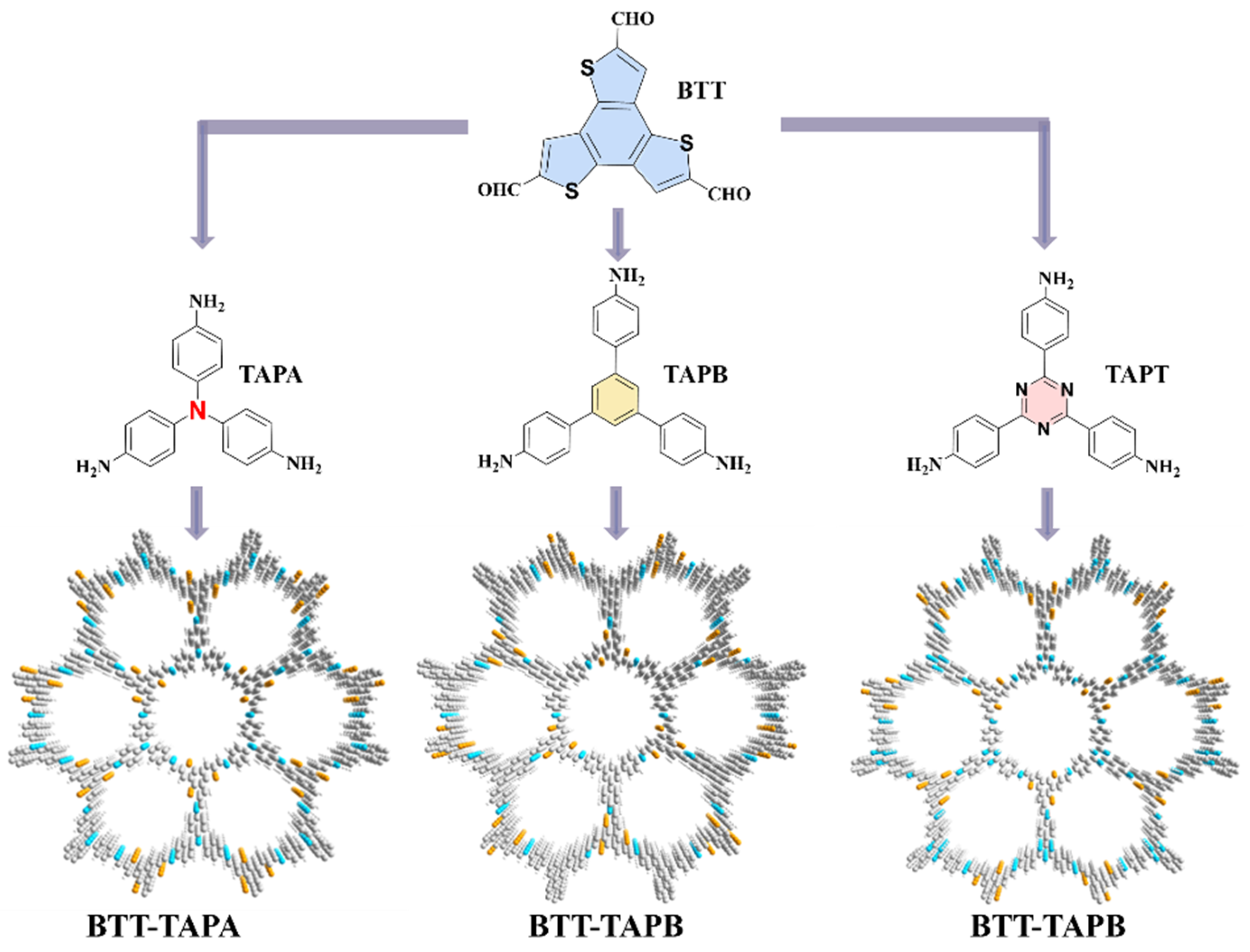
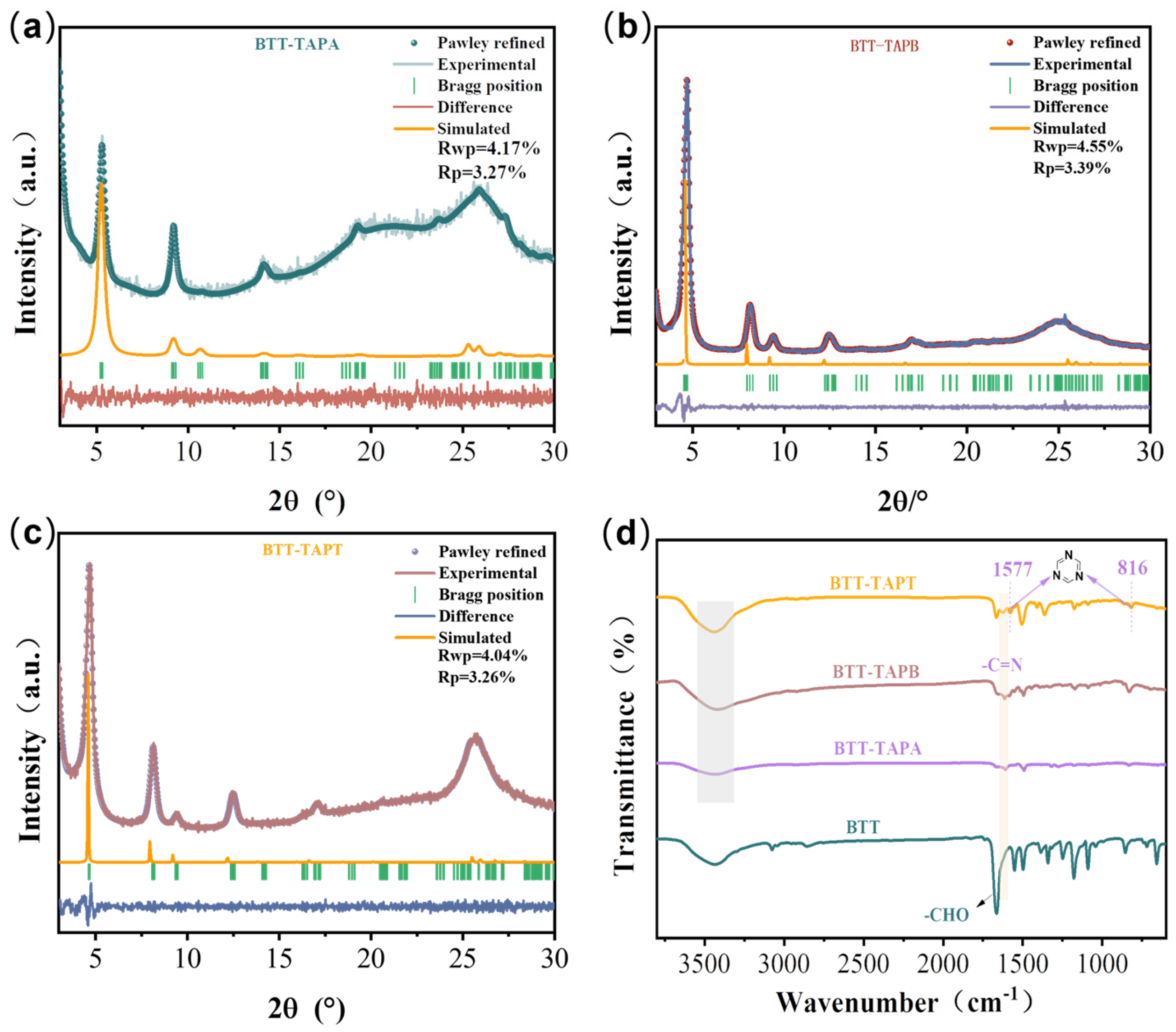
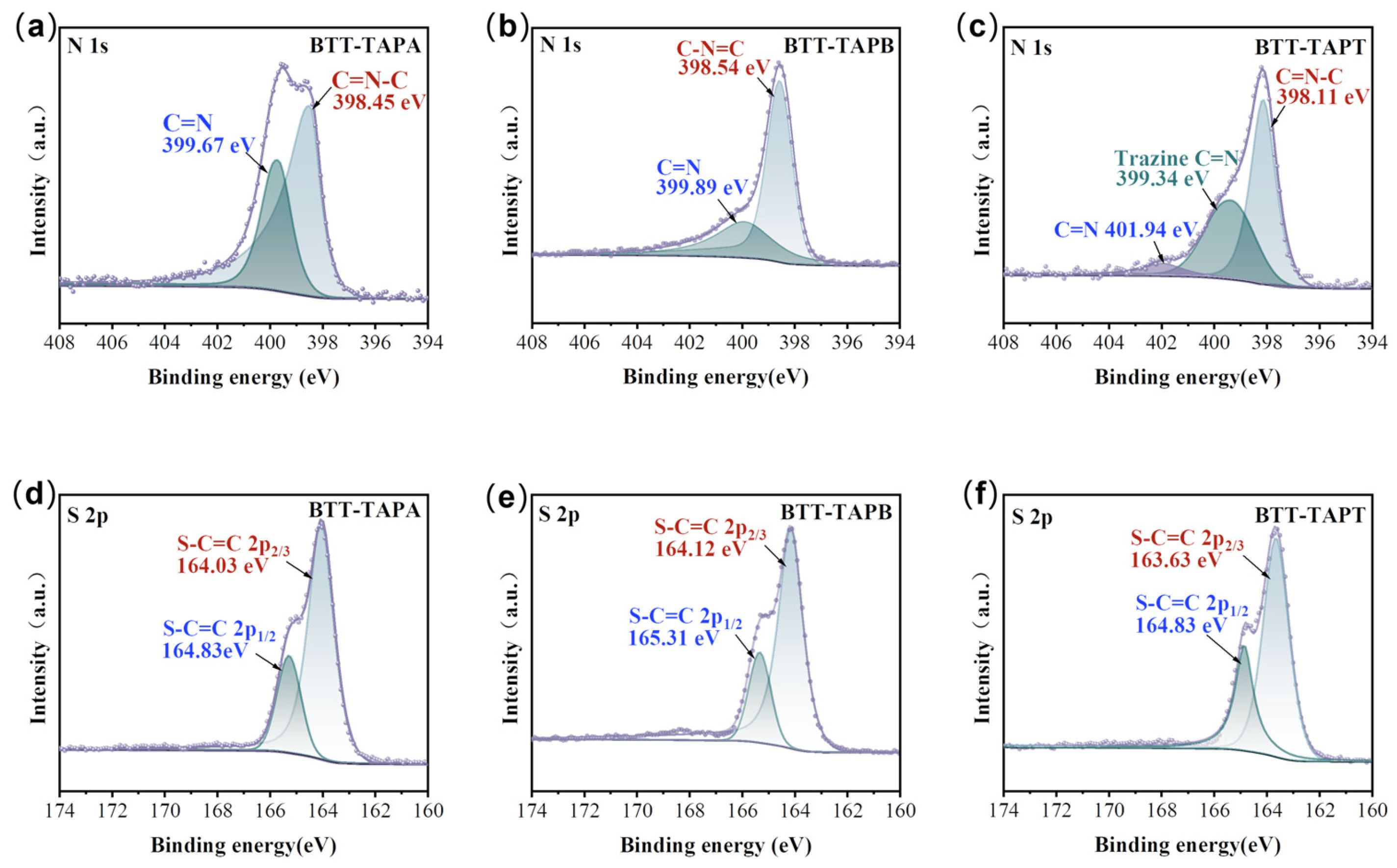



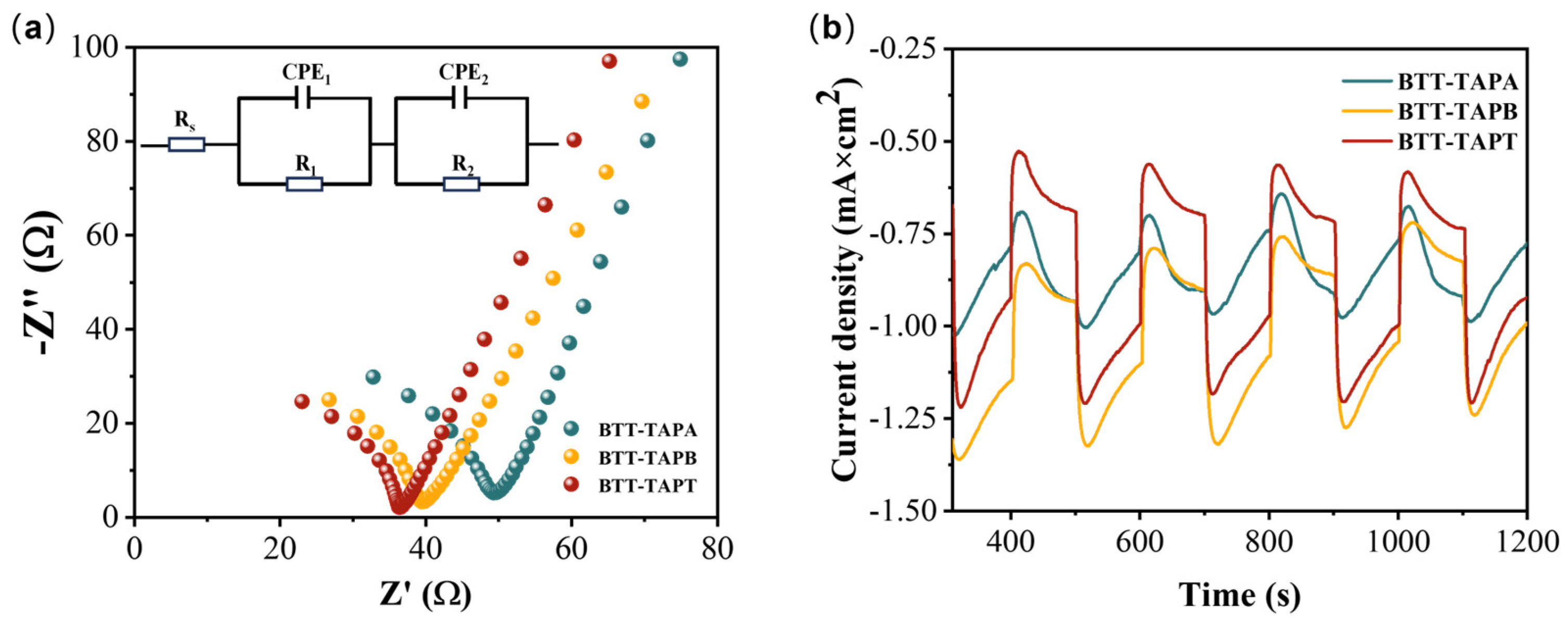

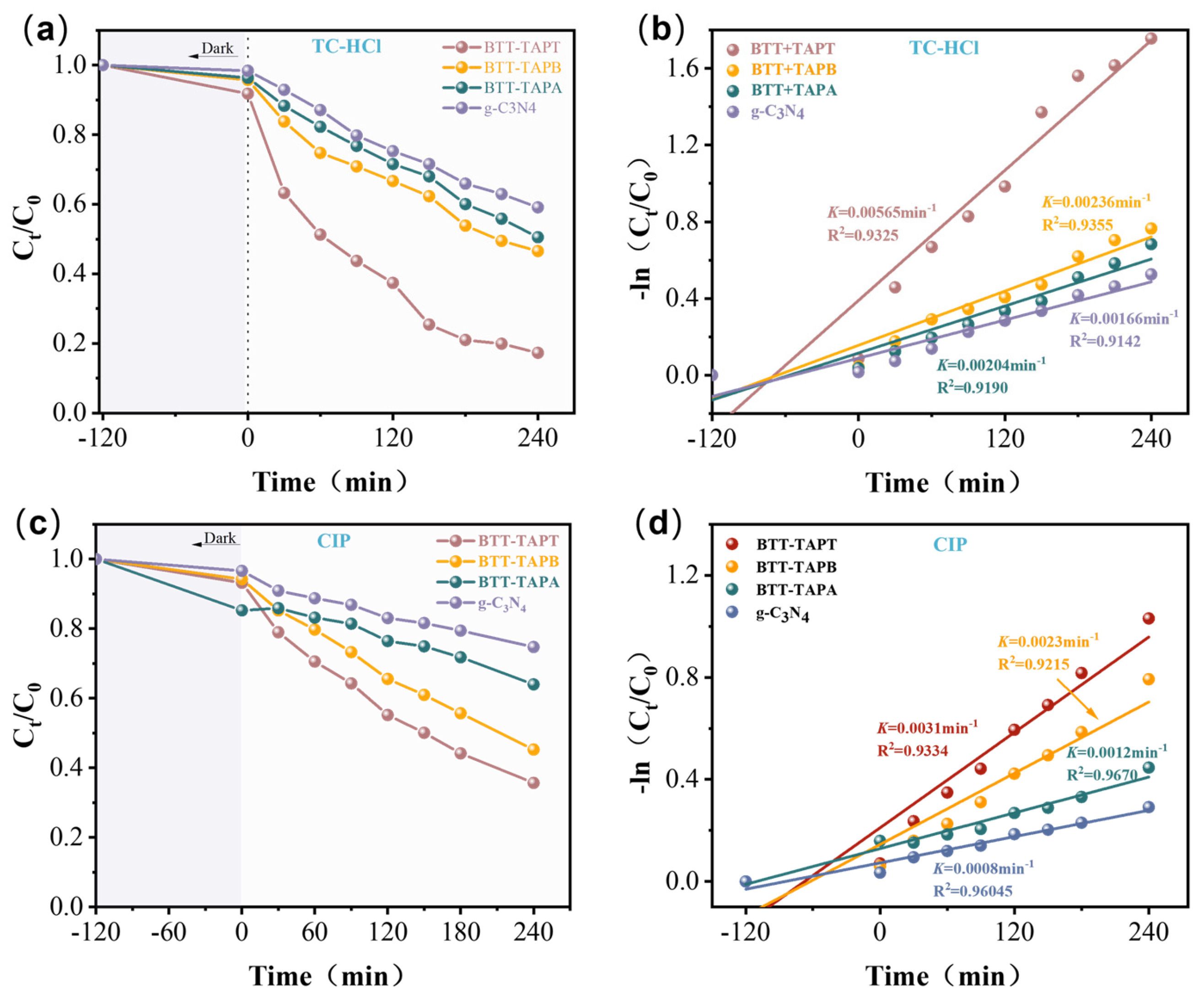
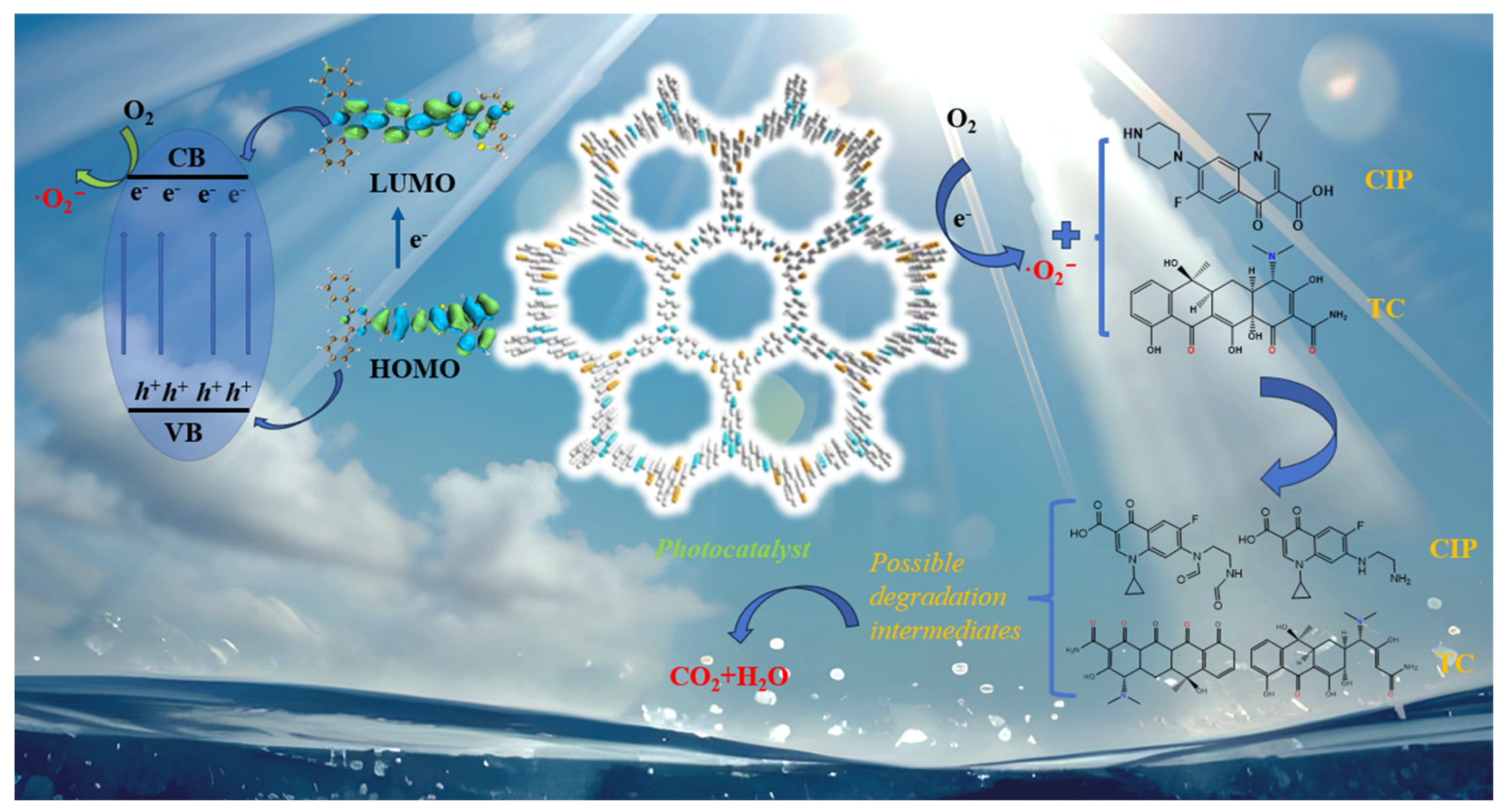
| Model | a (Å) | b (Å) | c (Å) | α | β | γ | Rwp | RP |
|---|---|---|---|---|---|---|---|---|
| BTT-TAPA | 19.18 | 19.18 | 3.52 | 90° | 90° | 120° | 4.17% | 3.27% |
| BTT-TAPB | 21.35 | 21.35 | 3.50 | 90° | 90° | 120° | 4.55% | 3.39% |
| BTT-TAPT | 22.20 | 22.20 | 3.49 | 90° | 90° | 120° | 4.04% | 3.26% |
| Sample | Dosage (g/L) | Concentration (mg/L) | Time (min) | Removal Rate (%) | Year | Ref. |
|---|---|---|---|---|---|---|
| Bi/BiVO4 | 0.5 | 10 | 60 | 74.7% | 2019 | [68] |
| Ag3PO4/5GO | 0.25 | 10 | 30 | 69.8% | 2019 | [69] |
| CdS | 0.4 | 100 | 60 | 80.0% | 2020 | [70] |
| PS/MNPs | 0.05 | 50 | 240 | 74.4% | 2020 | [71] |
| mpg-C3N4–ZIF-8 | 0.5 | 40 | 180 | 74.8% | 2020 | [72] |
| ZIS-TCN/3 | 0.1 | 20 | 60 | 86.1% | 2021 | [73] |
| g-C3N4/Ag/AgBr-8% | 0.32 | 20 | 30 | 57.5% | 2022 | [74] |
| US/BiVO4/PMS | >1 | 20 | 60 | 78.6% | 2023 | [75] |
| W1-TiO2-Et | 0.4 | 50 | 360 | 77.2% | 2024 | [76] |
| BiOBr/Bi2O2CO3 | 0.2 | 40 | 40 | 63.0% | 2024 | [77] |
| BTT-TAPT | 0.1 | 50 | 240 | 82.7% | 2024 | this work |
Disclaimer/Publisher’s Note: The statements, opinions and data contained in all publications are solely those of the individual author(s) and contributor(s) and not of MDPI and/or the editor(s). MDPI and/or the editor(s) disclaim responsibility for any injury to people or property resulting from any ideas, methods, instructions or products referred to in the content. |
© 2025 by the authors. Licensee MDPI, Basel, Switzerland. This article is an open access article distributed under the terms and conditions of the Creative Commons Attribution (CC BY) license (https://creativecommons.org/licenses/by/4.0/).
Share and Cite
Guo, H.; He, J.; Guo, Y.; Chang, Y.; Ju, H.; Li, Y. Electron Push-Pull Effect of Benzotrithiophene-Based Covalent Organic Frameworks on the Photocatalytic Degradation of Pharmaceuticals and Personal Care Products. Molecules 2025, 30, 336. https://doi.org/10.3390/molecules30020336
Guo H, He J, Guo Y, Chang Y, Ju H, Li Y. Electron Push-Pull Effect of Benzotrithiophene-Based Covalent Organic Frameworks on the Photocatalytic Degradation of Pharmaceuticals and Personal Care Products. Molecules. 2025; 30(2):336. https://doi.org/10.3390/molecules30020336
Chicago/Turabian StyleGuo, Hongguang, Jiaqin He, Yixi Guo, Yunxi Chang, Haidong Ju, and Yizhou Li. 2025. "Electron Push-Pull Effect of Benzotrithiophene-Based Covalent Organic Frameworks on the Photocatalytic Degradation of Pharmaceuticals and Personal Care Products" Molecules 30, no. 2: 336. https://doi.org/10.3390/molecules30020336
APA StyleGuo, H., He, J., Guo, Y., Chang, Y., Ju, H., & Li, Y. (2025). Electron Push-Pull Effect of Benzotrithiophene-Based Covalent Organic Frameworks on the Photocatalytic Degradation of Pharmaceuticals and Personal Care Products. Molecules, 30(2), 336. https://doi.org/10.3390/molecules30020336






